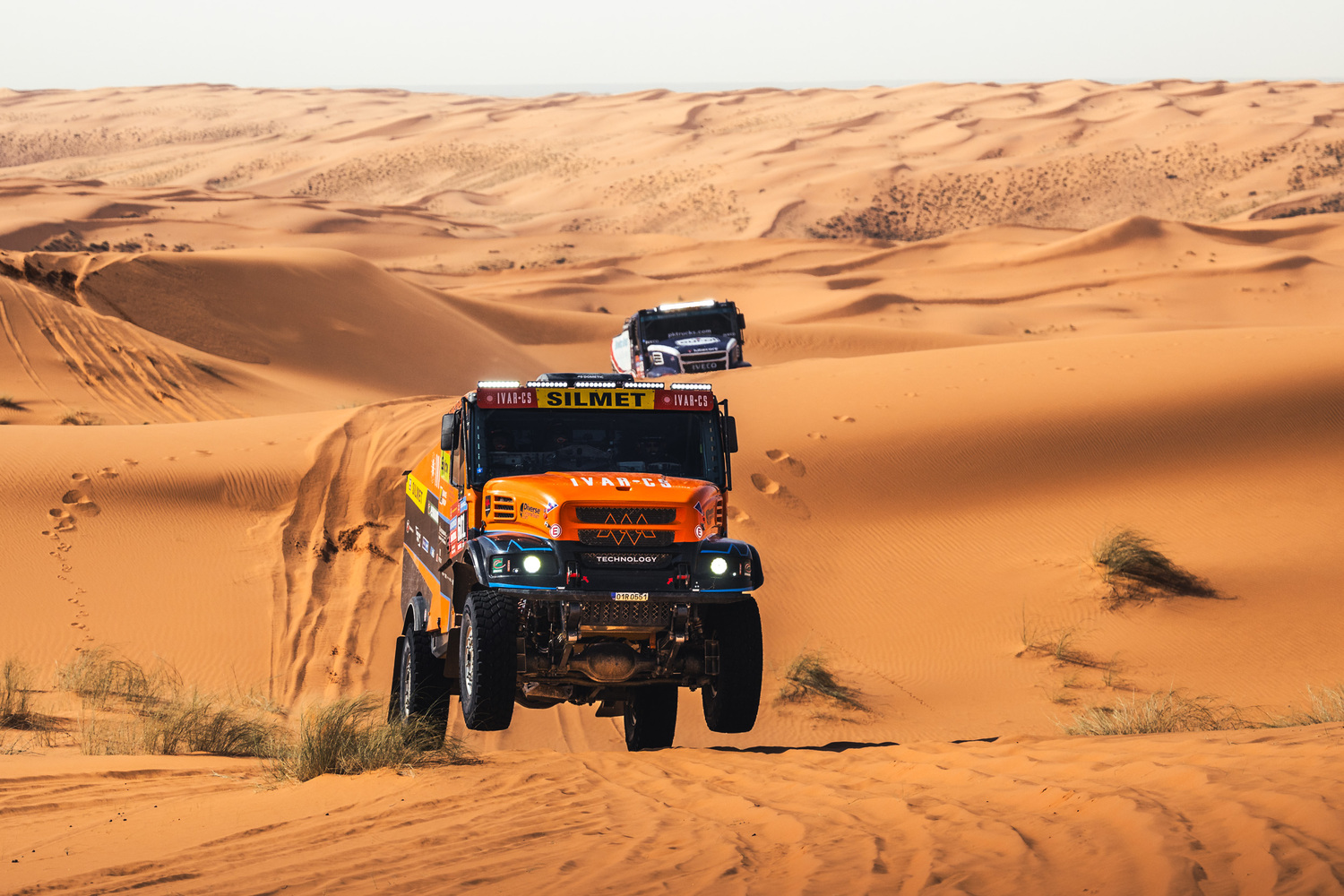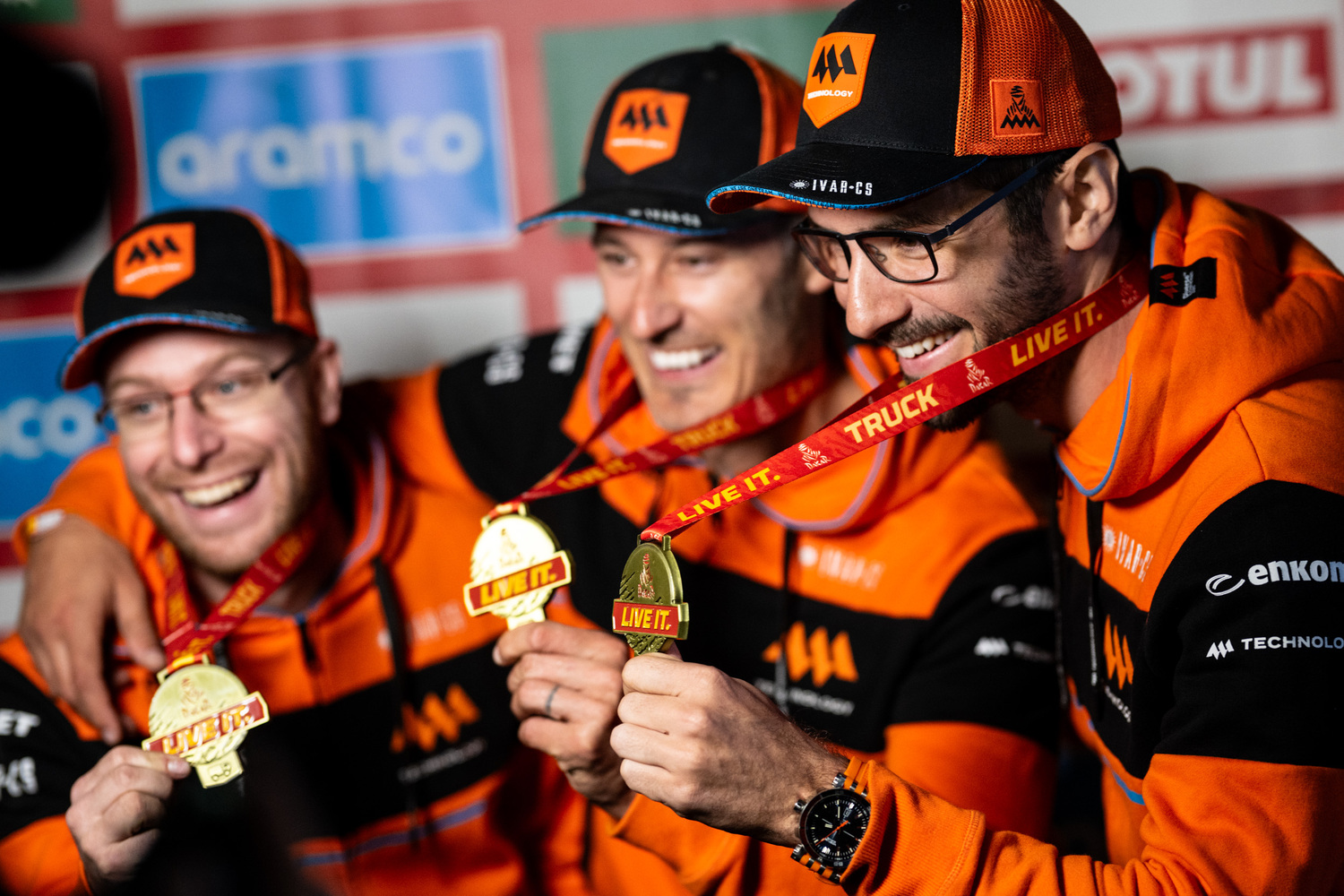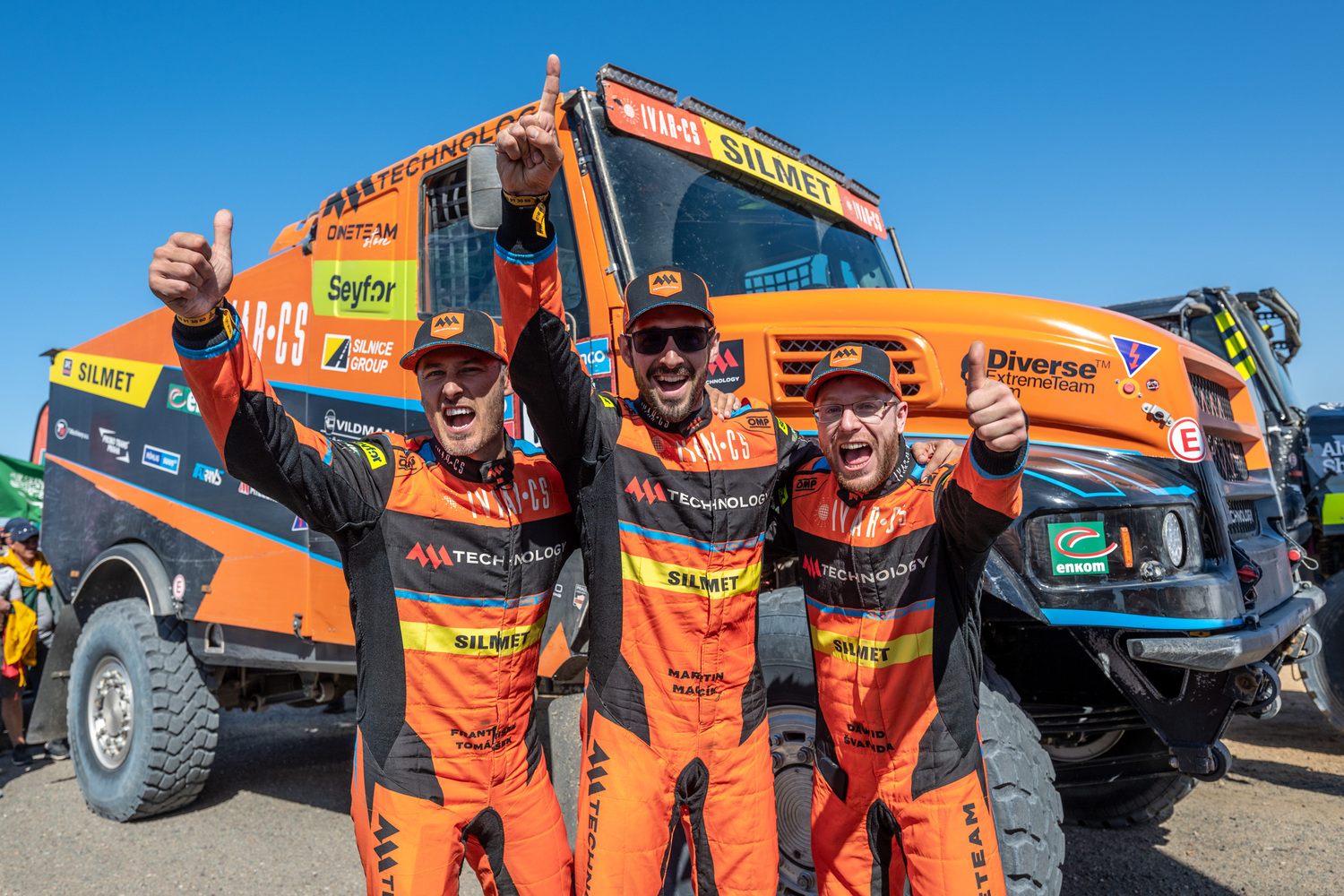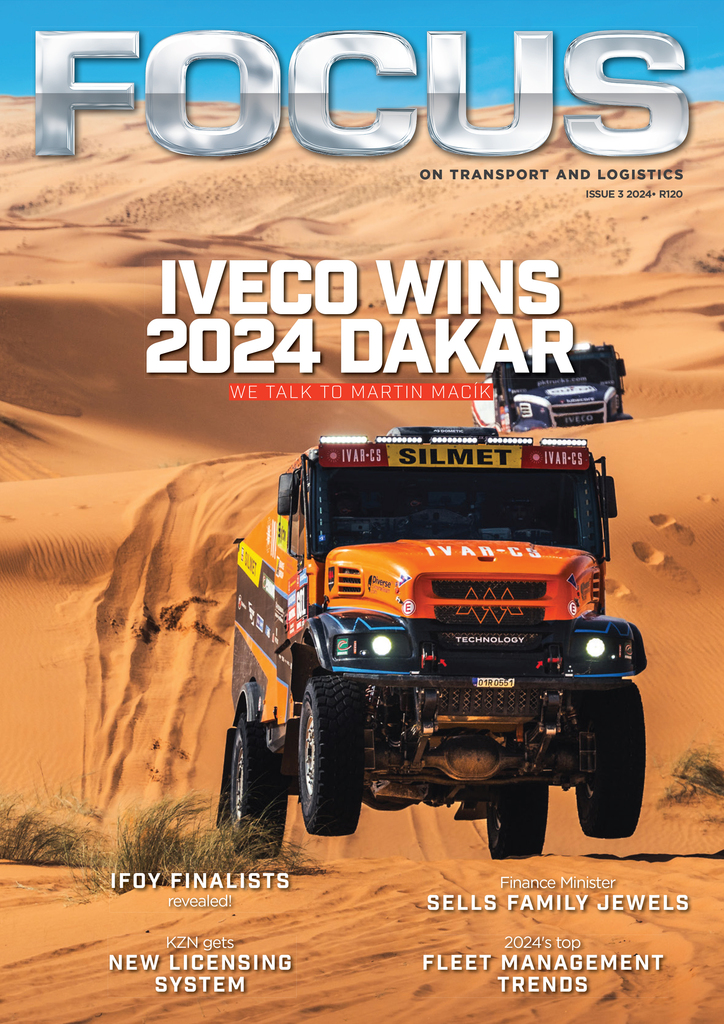One of the advantages of serving on the International Truck of the Year jury is the fact that it really opens doors. In this case, it opened the door to the Dakar-winning Iveco piloted by Martin Macík, who was one of an incredible seven Iveco drivers who finished in the Top 10 at the Dakar this year! It also secured us a personalised photograph! But, enough about the souvenirs; here is our exclusive interview with Macík, who notched up his first win in his faithful Iveco – affectionately nicknamed “Cenda”. This article was originally published in FOCUS on Transport & Logistics, South Africa's leading transport magazine. To read the full magazine, click here. The article can also be viewed on the FOCUS website here.
Can you outline the major steps in your career as a driver? Where and when did you start competing in motorsport and driving a truck?
It all started at the early age of five or six; I started with motorbikes, did some minor races, then I sat in the off-road car of my father. He was off-roading a lot and, in 2002, we went to see the Dakar Rally in Senegal. There, my father decided to go to Dakar the year after with an old LIAZ truck. I was 13 years old, but I was hooked from that moment!
I didn’t do much in racing until I was 20, though. In 2009, I navigated for my father in his truck the whole year except for the Dakar (so, I took part in the Silk Way Rally, Baja Aragon, and Hungarian Baja). “First university, then Dakar,” my father said. So, I graduated and started as a navigator in 2013 and 2014. After gaining some experience that way, I started on my own behind the steering wheel in 2015, with my father’s support.
How do you compare the Dakar in South America with the Dakar in Saudi Arabia?
The biggest difference is the people: in South America, there are so many fans around the track, cheering for you all day long, it doesn’t matter what position you’re in. In Saudi, you don’t see many of them. Comparing the different Dakar routes is difficult because it’s a completely different environment; Saudi has all types of terrain.
And what about the difficulty?
Well, this year was definitely the hardest Saudi Dakar – and I believe one of the hardest in Dakar history – because of the long distances every day, the Chrono 48 stage (a new stage held over two days in which the competitors, scattered among eight bivouacs, were basically left to their own devices), and the annoying dust.
Can you tell us the story of your Dakar this year? What were the main turning points in the race and when were you confident of winning?
You are never confident that you’re going to win, but the main turning points were stages five and six, because I went from being 45 minutes behind the leaders to being in the lead myself.
Chrono 48 (stage six) was a two-day stage of 570km in dunes only. This was very demanding; there were hundreds of metres-high dunes of sand and everything was difficult. We started first, finished first, and slept in the middle of the desert without any service support.
We didn’t know anything about the standings or anything else – and we finished first with a lead of an hour over the second vehicle. That was unbelievable and from that moment I knew inside. Most importantly, I could believe in my truck in every kilometre of our journey. It worked like never before!
Who was the most challenging competitor this year? Aleš Loprais? Mitchel van den Brink? Janus van Kasteren? Anyone else?
I would say Janus, especially at the beginning of the race. He won the stages, so he was starting with no dust (that was very helpful), and he is incredibly fast. But he didn’t do well in Chrono due to technical problems and we just overtook everybody. After that, we were able to observe the rest and how they were battling each other.
How can you describe your driving style? Are you aggressive, or a cool tactician?
I do what’s needed in a particular moment of the race; I drive with my head and don’t do crazy stuff. I manage the truck in order to be able to go faster every kilometre and every day. My goal is to compete until the end of Dakar. It’s cross country and a navigational rally; you can be aggressive and win a stage but that won’t win you a Dakar. Of course, though, you must be fast and consistent and you must have a great truck, which we have with our Iveco.
Can you explain the role of your Iveco Powerstar in achieving this result – was it reliable and high performing, as you expected? How did you modify your Powerstar compared to last year’s truck? Are you using an automatic gearbox? Do you like it?
The key to winning the Dakar is having a really great vehicle. The truck I drive is called “Cenda”. It was developed by MM Technology and powered by the Iveco 13 Cursor (which generates over 1,000hp of power and over 5,000Nm of torque), while the gearbox is an automatic Allison. It’s really fun to drive even though I miss a manual, which allows me to play with the truck more.
Our truck was really responsible for half of our achievement, thanks to its performance and reliability. This is very important. This year, we actually only made a few changes on the chassis set-up and some other minor technical changes, because we knew it was already a great truck last year. The biggest advantage of our truck is definitely its compactness, with low weight balance and easy control. I just love it. The rally was seamless for us thanks to our truck.
Can you tell us anything about your future projects?
We are building new trucks – either for us or for our clients. We also maintain them and compete in various other rallies. That’s what we want to do; we want to move ahead and create the best rally trucks in the world.
• We would like to acknowledge Gianenrico Griffini, President of the International Truck of the Year jury, who sourced this story for us.

HOW THE RACE PLAYED OUT
The Czech Republic flag fluttering in the breeze above the Lac Rose is a classic image from the 1990s, an era synonymous with the Tatra driven by Karel Loprais, who last won back in 2001. Back home, his compatriots were counting on his nephew, Aleš Loprais, who has come close to winning the Dakar many times (he was third in 2007, fourth in 2015, and fifth in 2019-21).
In the end, though, it was Martin Macík who put the Czech Republic back at the top of the truck category, doing so with plenty of panache. At first, no one seemed able to beat Janus van Kasteren in the fight for the title, not even Aleš Loprais, his main rival last year. Loprais tried valiantly at the beginning of the race, but Van Kasteren was always a step ahead. As for Macík, he took time to warm up. After trailing by three-quarters of an hour on the evening of stage four, he displayed patience, waiting to pounce on his rivals’ slightest mistakes.
As the saying goes, time comes to those who wait. During the 48-hour Chrono stage (the two-day sixth stage which Macík deemed to be the hardest from any of his 12 Dakar rallies), Loprais lost more than one hour in the dunes of the Empty Quarter. Van Kasteren lost even more time, crushing the Dutchman’s hopes of defending his title.
This propelled Macík to the top of the general rankings. Behind the wheel of his trusty Iveco, affectionately nicknamed “Cenda”, Macík featured in the top three in every stage from day five of the rally onward. With four stage wins under their belt and a lead of almost two hours on arrival in Yanbu, the Iveco crew triumphed!

WHO IS MARTIN MACÍK?
At just 34 years of age, Martin Macík lined up for his 12th Dakar this year. The charismatic Czech entrepreneur has followed in the footsteps of his father Martin Senior, who first competed in the world’s toughest rally in 2003.
The younger Macík began his Dakar career in 2013 as a navigator for Vlastimil Vildman, before switching to the driver’s seat from 2015 onwards. Over time, he has become one of the leading truck contenders. The absence of the Russians in 2023 threw the truck category wide open and led to a fascinating Czech-Dutch battle last year between Macík, Aleš Loprais, Jaroslav Valtr, the Van den Brinks, and eventual winner Janus van Kasteren. Last year, Macík had to be content with second place overall despite four stage wins, but he didn’t begrudge his good friend Van Kasteren the title.
Macík returned in 2024 as one of the main favourites, even if he insisted that the challenge of winning the Dakar was as hefty as his 10-tonne Iveco Powerstar.
His hobbies are “anything with an engine” and basketball.

IVECO AT THE DAKAR
Iveco has a long and illustrious history at the Dakar. The Paris-Dakar Rally was conceived in 1977 but the 1980 edition was marked by a major first: the inclusion of trucks.
In 1982, Iveco joined the Dakar adventure, starting a long journey full of great results and unforgettable moments. In the memorable Dakar 2012 event, Iveco achieved its first win, with Dutch driver Gerard de Rooy and his team claiming first, second, and sixth place. Last year, Iveco won the race as well through Janus van Kasteren, who drives an Iveco Powerstar, so this year’s victory is nothing new to the Italian truck manufacturer!

